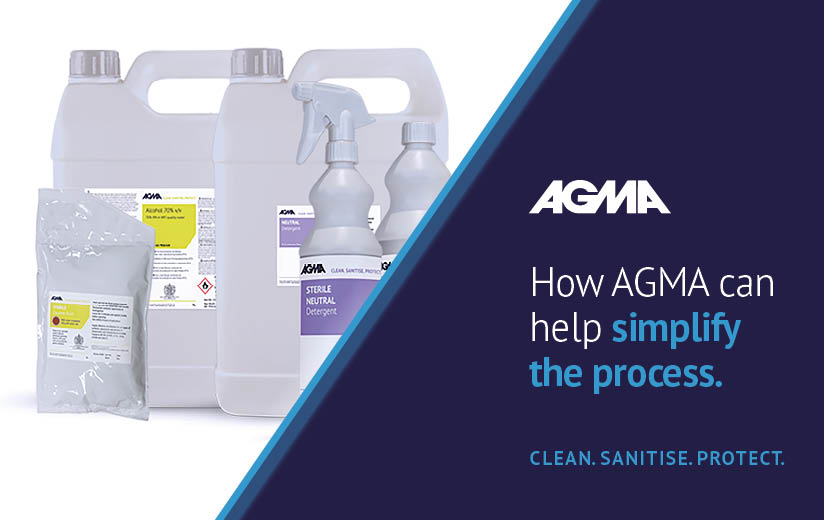In production cleanrooms it’s essential to control microbial contamination in order to avoid biocontamination of the finished product which could have fatal consequences for the recipient. In order to reliably remove biocontamination from the environment in critical production areas it is essential to identify, select and apply the most appropriate cleaning and disinfectant products for your particular facility.
It is essential to prevent contamination from entering the Cleanroom manufacturing area in the first instance as well as eliminating it from the Cleanroom once it has found its way in there. Information is the key as controlling contamination begins with understanding exactly what is present in or around the facility, and how the ensuing risks can be mitigated. This is established via routine environmental monitoring allowing Cleanroom microbiologists to gain an understanding of the types of microorganisms (bacteria, fungi, viruses, spores) are presenting a risk within the production facility, as well trending when, where, why and how this changes over time. Constantly monitoring and trending data is an integral part of any contamination control strategy in line with cGMP.
Having established the types of microorganisms present you are then able to define the most appropriate cleaning & disinfection regime and select the most suitable products to effectively remove the contamination. Cleaning prior to disinfection is paramount as disinfectants have poor penetrative ability. Any residues from the cleaning process will need to be removed as these may also interfere with the disinfectant’s efficacy. Successful cleaning practices recognised to the visual cleanliness level are capable of removing visible residues, particulate contamination and minimising microbial contamination.
The various cleaning and biocidal products available to Cleanroom microbiologists are formulated to contain different active ingredients with different modes of action and efficacy. It is therefore advisable to check their compatibility or ideally source all cleaning & disinfection products from the same manufacturer as they will have been designed and developed to work as a fully validated, compatible system. A sporicide should be incorporated into any disinfection regime across all grades of cleanroom in order to maximise the spectrum of kill. Being proactive is better than being reactive in critical areas and producing sterile medicinal products or medical devices is all about continuous product and process improvement. Your contamination control strategy should be used to drive continuous improvement throughout the facility.
In order to make an informed decision when faced with a choice of several cleaning & disinfection products from different manufacturers it is important to consider the following with respect to your facility:
1. The biological targets you have identified.
2. The application method that will be used for the biocide. Is the product you have chosen validated for your chosen method of application as per your facility SOP’s.
3. Contact/dwell times – does this fit with your work schedule.
4. Surface compatibility
5. Any Health & Safety issues
6. What type of testing/validation has been undertaken by the manufacturer of the biocide and are the representative organisms against which it has been tested significant for your facility.
It is vital that the disinfectant selected has passed international standards which prove effectiveness. The table below shows some examples of tests which are necessary for products to make various biocidal claims. Results are listed for each species tested and substantiate a biocidal claim based on the representative organism. There are a wide variety of tests, each with optional and mandatory organisms which are included to make different claims. AGMA biocides have all exceeded the pass criteria for the appropriate efficacy claims.
| Testing type
(depending on organism) |
Suspension in solution | Surface with approximated conditions of use |
| Bactericidal | BS EN 1276 | BS EN 16615 |
| Fungicidal / Yeasticidal / Bactericidal | BS EN 1650 | BS EN 13697 |
| Sporicidal
|
BS EN 13704 | BS EN 17846 or BS EN 16615 |
| Virucidal
|
BS EN 14476 | BS EN 16777 |
Simplify with AGMA solutions
When selecting a product to manage biocontamination in a cleanroom environment, AGMA can help you simplify the process with high quality, BS EN tested, 0.2 micron filtered products:
- Eliminate bacteria & enveloped viruses on hands with good handwashing technique and a hand gel such as AGMA Mysogel.
- Gloves should be inspected & disinfected on an ongoing basis as determined by your SOPs.
- All environmental surfaces should be cleaned with a Neutral Detergent prior to disinfection as per cGMP guidelines.
- Once surfaces are clean and dry, disinfect using a validated, broad-spectrum biocide which leaves no residue, such as 70% Isopropanol or 70% Denatured Ethanol via spray and wipe or impregnated wipes as per your facility SOPs.
- Incorporate a validated sterile sporicide such as Zyceine in your regular cleaning and disinfection routine carefully following the manufacturer’s instructions for preparation, application and contact time.
- Remove any sporicidal residue by wiping with sterile alcohol or sterile, WFI quality water as determined by your facility SOPs.
For more information and to find the right products to use within your environment, discover AGMA’s fully compliant cleaning and disinfection solutions by downloading our healthcare brochure.


